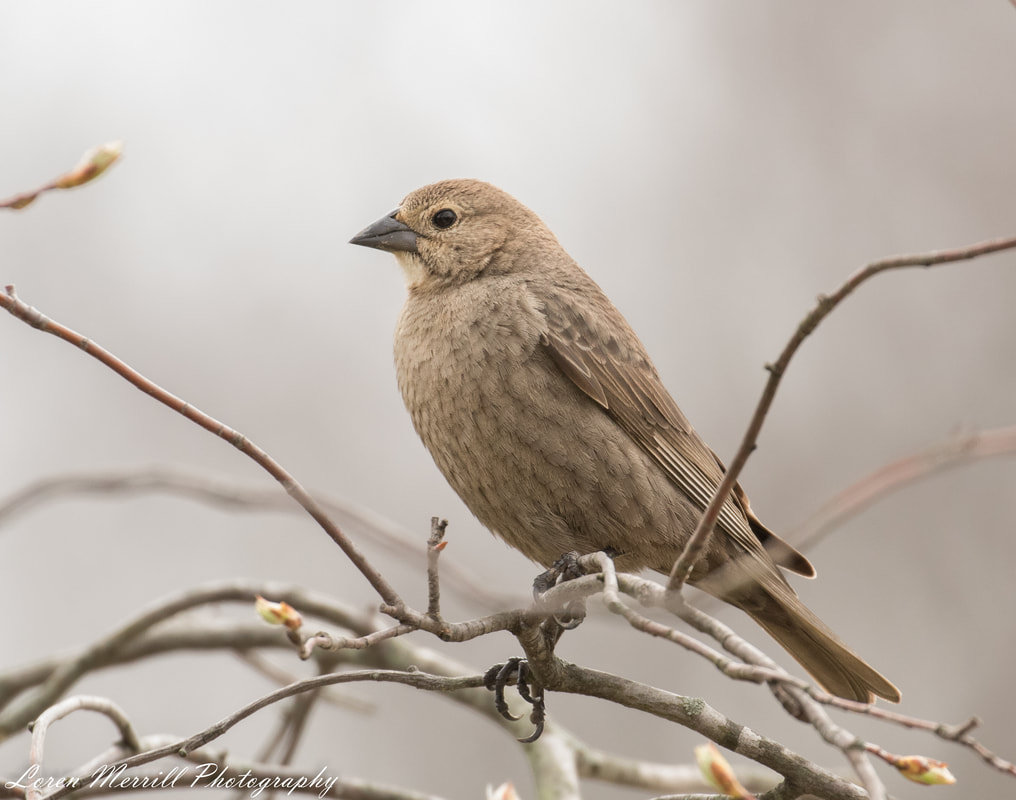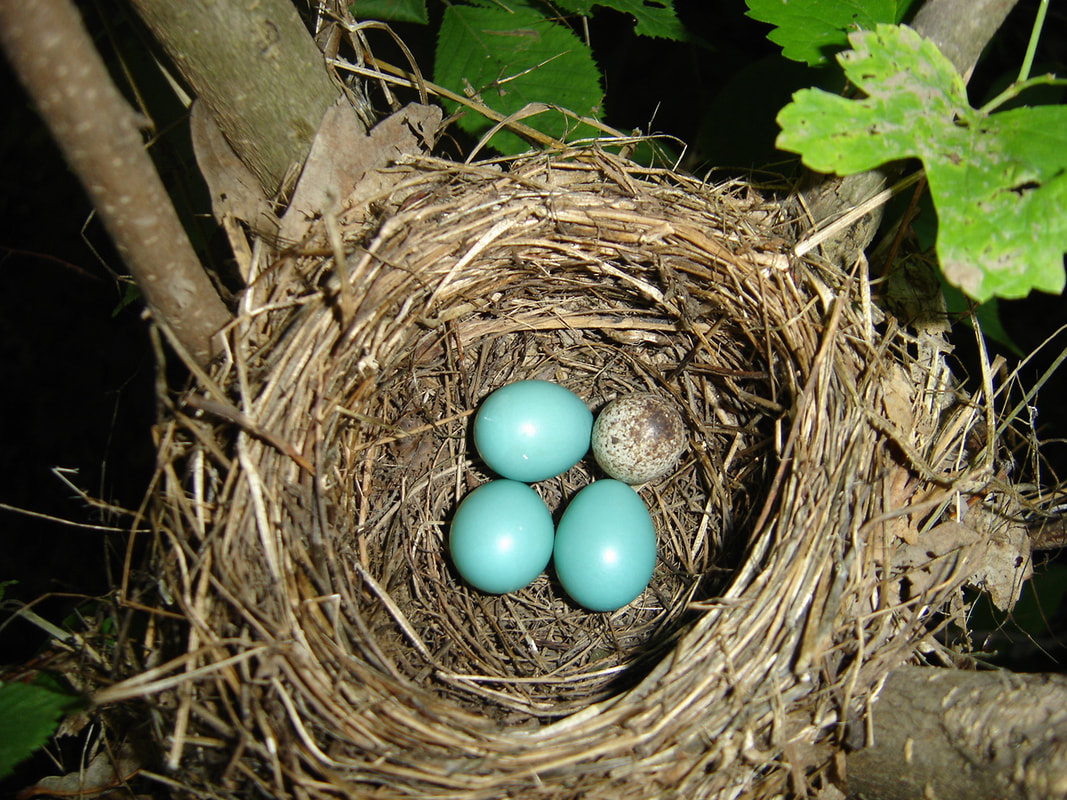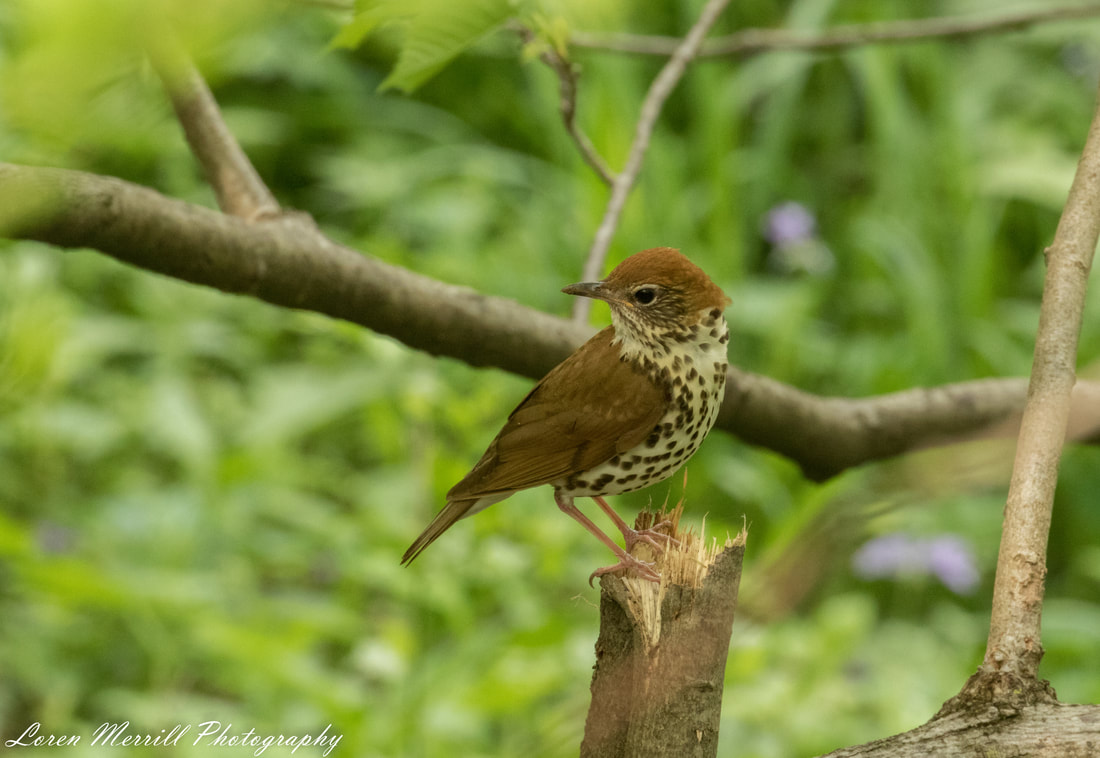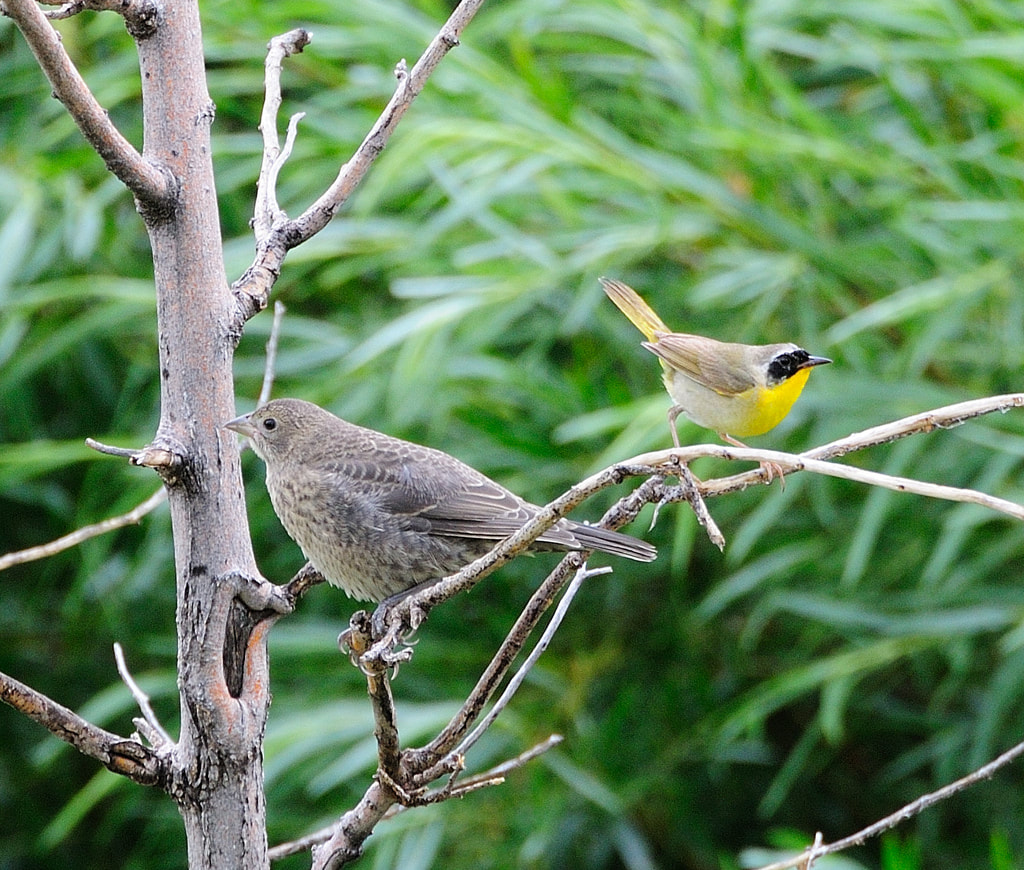|
Imagine for a moment that you’re a female wood thrush, and you’ve been busy over the past week building a cozy nest-home that is now populated with four lovely eggs. You look down into the nest to admire your handiwork when you realize something is off; one of the eggs in the nest doesn’t look like the others. Three eggs are blue and unmarked, whereas the “other egg” is a little smaller, less blue, and has some speckling. “That’s odd,” you muse to yourself as you study this aberrant egg. “Did I eat something bad last week?” You think back over the week’s menu of squishy invertebrates and desiccated fruits. “Maybe it was that caterpillar with the spiky hairs, or those old mystery berries,” you speculate. Regardless, you have a decision to make: will you keep this mismatched egg, or toss it from your nest? You consider the options. On the one hand, it’s an egg in your nest, so it seems as though the most likely scenario is that if came from you. On the other hand, you’ve heard rumors of an egg-dumper in the neighborhood--an unknown bandit going around, depositing eggs in the nests of others. Could this be an imposter egg that was swapped in for one of your own? If that’s the case you could be wasting valuable resources by continuing to incubate the egg, and worse still, feed it once it hatches. But what if it really is just a weird looking runt egg you made because you ran out of blue pigment and hadn’t eaten much the day before? If you toss it, you’re throwing out your own offspring, and given that the odds of you surviving to the next breeding season are pretty slim, the loss of one offspring is a big deal. So you decide to keep the egg. You settle down on the nest, and for much of the next 11 days, you devote yourself to keeping the eggs warm and safe. On the 11th day, the misfit egg cracks open, revealing a small, blind, and featherless chick. As you gather up the broken bits of eggshell for disposal away from the nest, you inspect the exhausted chick. Aside from the fact that it hatched earlier than the other eggs and looks a little small, this naked hatchling appears normal. Within a few hours it has recouped its strength and starts begging for food. Your partner begins bringing small, soft-bodied invertebrates to the nest, and stuffs them into the chick’s oversized mouth-funnel. The next day, the other eggs hatch, and soon you’ve got four mouths to feed. Over the first few days post-hatch your partner does most of the provisioning as you continue to brood the young chicks, keeping them warm and safe from predators. But soon the four chicks (which are really just stomachs with mouths) require more food than your partner alone can provide, so you begin helping gather food. As you go back and forth from nest to forest collecting caterpillars, spiders and the like, it seems as though Chick 1 (your descriptive name for the first-hatched chick) is always begging, begs louder, and may be getting more food than the others. This concerns you for a little while, but you are quickly overwhelmed with work, and all thoughts of nestling inequity vanish behind the all-consuming job of providing food for the four noisy bobbleheads in your nest. The next week vanishes in a blur of high intensity parenting, and before you know it, you’ve got four teenaged fledglings looking tough with their punk feather-dos, crowding the nest and pooping everywhere. And one of those indiscriminate poopers has a funny look about him. Rather than the rufous undertones and defined spotting that the other chicks are sporting, he’s got a dull gray coat, and some messy streaking on his chest. “I should really watch what I eat next time I’m laying eggs,” you think to yourself. And then, one day, when all your other teens are testing out their wings, flying into tree-trunks and the mouths of waiting predators, Chick 1 vanishes. You call for him, and fly around desperately looking for him, but there’s no sign anywhere. You return to your other offspring and spend the next few weeks getting them ready for life on their own. The next time you see Chick 1 is a month later and he’s hanging out at the edge of a large field with a gang of cowbirds and grackles. You call to him, but he pretends not to hear you, and that’s when you realize what’s happened; your son isn’t just hanging out with a bunch of cowbirds. He IS a cowbird. Your fears are confirmed: you spent a month raising a brood parasite. Brood parasites come in a couple of flavors, and like ice-cream, none of them are good for you (if you’re a host). There are obligate brood parasites which only lay their eggs in the nests of other species. There are facultative brood parasites, which are species that will opportunistically lay their eggs in the nests of other species when the situation presents itself (many ducks will happily drop an egg or five in the nest of another duck species if the opportunity arises). And there are intraspecific brood parasites, which are individuals of a species that will deposit an egg here or there into the nest of another member of the same species. Obligate brood parasitism is thought to have evolved seven different times in birds; in the New World blackbirds (cowbirds), the Old World viduine finches (indigobirds and whydahs), the African and Asian honeyguides, one species of duck (the black-headed duck), once in the Old World cuckoos, and twice in the New World cuckoos. None of the obligate brood parasites build their own nests or raise their own offspring; every egg that a female lays she deposits in the nest of another species. Aside from that one shared trait, obligate brood parasites exhibit a fascinating array of strategies for duping the foster parents and rigging the odds in favor of the parasitic chick. Regarding the latter, some brood parasites have evolved rather ruthless tactics for ensuring that they get plenty of attention from the host parents. Old World cuckoos get to work on this almost as soon as they hatch. Blind, naked, and barely coordinated enough to keep from toppling over, the cuckoo chick endeavors to eliminate all competition from the nest as fast as possible. They do this by scooting backwards around the cup of the nest, and when they encounter something like an egg or another chick, they begin pushing it up the side of the nest. The single-minded parasite chick accomplishes this task by balancing the egg or chick on its back until it reaches the rim of the nest, and then, with a final heave, the egg or chick is pushed over the edge. The cuckoo repeats this action until it is the sole occupant of the nest, thereby ensuring that it will receive all the food that the host parents bring to the nest. But the trophy for most grisly tactic goes to the honeyguides. Adult honeyguides are named after the behavior displayed by one or two African species which have developed a symbiotic relationship with humans, possibly dating back as long as 2 million years. These birds have a particular fondness for bee larvae and wax, but don’t have the means of breaking into natural beehives. Luckily for them, people have a particular fondness for honey, and the means of breaking into the hive to get it. So the honeyguides lead people to bee colonies where the humans use tools to open the hive and scoop out the honey. Once the two-legged honeyeaters are done, the honeyguides move in to collect the bee larvae and the wax (honeyguides are one of the few animals that can digest wax). The cooperative nature of the adults belies the sinister behavior their chicks exhibit upon hatching. Honeyguide chicks emerge from the egg with some lethal hardware; a sharply pointed and curved-tipped bill, which they use to quickly dispatch their nest-mates. The host parents eventually remove the dead chicks, and the little parasite nestling is all that remains. With no competition for food, the honeyguide chick grows rapidly, and is soon out in the world, looking for its own humans to break open beehives. Not all obligate brood parasites are as virulent as the Old World cuckoos and honeyguides, however. In North America, the brown headed cowbird is by far the most wide-spread and common obligate brood parasite, and the impact of the parasite on the host is much more variable. A cowbird chick in a nest of red-winged blackbirds is thought to have relatively little negative impact on the parents or host chicks, other than the loss of the one egg that the female cowbird removed and replaced with her own egg. In contrast, a cowbird chick in the nest of an eastern phoebe, or a common yellowthroat has a much bigger impact. The larger parasitic chick typically outcompetes all the host nestlings, which often succumb to starvation. There are few questions that regularly arise at this point in the story—“Why do brood parasites exist at all?” “Why don’t the hosts stop the brood parasites?” and “Why don’t all birds do this?” There are many answers to these questions, and numerous researchers have spent their careers pursuing these questions, or variants of them. The first question is relatively easy to address; if you could get someone else to invest considerable resources into the growth and development of your offspring at little to no cost to you, you would jump at that opportunity! Or some of us with more parasitic tendencies would anyways. To think in these terms, you have to ignore the emotional and hormonal mechanisms humans have evolved as a way to ensure that adults provide their children with the nurturing and care they need to develop properly. As a fun thought exercise, consider a world in which another species of hominid co-occurs with us (we’ll call them Homo parasiticus), and this species provides no parental care at all. Instead, they sneak into hospitals at night and deposit their offspring into the cribs with Homo sapiens newborn infants. Their babies look so much like ours, we can’t tell them apart, and are obligated to raise both babies (genetic testing would be the end of this parasitic species, alas, at least in developed nations). The H. parasiticus adults are free to invest all their time in work, leisure, research, arts, the development of nuclear fusion, space-travel, crossword puzzles, etc. Moreover, without the economic constraints of child-rearing, they are free to reproduce at much greater rates. This strategy is a great success! And this leads us to the next question: Why don’t hosts stop the brood parasites? The short answer is that many hosts do, or try to anyways. In many cases, there is an evolutionary tug-of-war, or arms race, at play. Many of the cuckoo hosts in the Old World have learned to recognize their own eggs, and any parasite egg that looks different is rejected. This in turn has led to egg mimicry on the part of the cuckoo; that is, they now produce eggs that look like the eggs of their hosts. You can see where this is going. In North America, the brown-headed cowbird has experienced largescale range expansion over the past 200 years as humans (and their cows, which cowbirds are often associated with) have spread out and modified the habitat across the continent, often to the cowbird’s liking. This means that there is now a spectrum of host-parasite relationships in place. In areas where cowbirds historically occurred, many of the hosts have strategies to deal with the parasites. Yellow warblers, for example, will abandon their nest or build a new nest on top of their old nest if a cowbird has parasitized it. American robins are experts are recognizing foreign eggs, and almost always remove them from their nests within a day or two. But species that historically didn’t experience high rates of cowbird parasitism often have no defenses and accept cowbird eggs without prejudice. One prominent theory suggests that the lack of parasite defenses in these hosts is a product of “evolutionary lag” and that, in time, hosts will evolve strategies for coping with the parasites.
But there are other reasons why hosts may accept the brood parasite’s eggs. One possible (and slightly controversial) reason is that brood parasites employ some Mafioso-type tactics to ensure that the hosts accept their eggs. There are no severed horse-heads or concrete-boots involved, but the idea is that the female brood parasite will return to a host nest where she has deposited one of her eggs, and if the host has removed that egg, the female parasite will destroy the nest. This serves two purposes; one, it forces the host to re-nest, thereby providing the parasite with another opportunity to parasitize the nest, and two, it acts as a warning to the hosts: “Remove my egg, and I will destroy your entire home and all your babies!” You can see how this would be a convincing argument, especially with no birdie law-enforcement around to help. Other explanations for why hosts may accept parasite eggs have to do with learning (it’s possible that host females have to learn what their own eggs look like before they can identify a foreign egg, and if a parasite egg is in their first nest, they may not learn to recognize it as a parasite), costs of mistakes (rejecting your own egg by mistake, or accidentally damaging your eggs in the process of trying to remove the parasite egg can be quite costly), and evolutionary constraints (e.g. egg recognition isn’t part of the species’ evolutionary repertoire, they are too small to remove the parasite egg, or they have a bizarrely-shaped bill that won’t allow them to move it, etc.). The final question regarding “why doesn’t everyone do it if it’s so great?” is multifaceted. First, and most obviously, if every species were a brood parasite, there would be no host species to raise them. Slightly more nuanced than that is the idea that hosts and parasites are governed by frequency-dependent processes; the more parasites there are, the stronger the selection on the hosts to counter the parasites. Another possibility is that maybe it’s not so great to be a brood parasite after all. At least, not a female brood parasite. Female cowbirds, for example, live less than two years on average, and some of my PhD work indicated that female cowbirds have significantly reduced levels of immune function compared to male cowbirds and both males and females of the closely related, but non-parasitic, red-winged blackbird. The idea behind this is that female cowbirds invest huge amounts of resources into egg production (laying as many as 20-40 eggs in a season) and that this comes at the expense of their health and ultimately survival. Brood parasites often get a lot of bad press, but the reality is that they are simply doing what evolution has molded them into doing. And when you stop to think about all the adaptations they have for this unique lifestyle, you can’t help but be amazed by them. Subscribe to the Newsletter! If you would like to get notifications about when new posts are up and other tidbits related to the blog, sign up for the View Out the Door twice-monthly newsletter. Just email viewoutthedoor “at” gmail “dot” com with the subject header SUBSCRIBE.
0 Comments
Leave a Reply. |
About the author:Loren grew up in the wilds of Boston, Massachusetts, and honed his natural history skills in the urban backyard. He attended Cornell University for his undergraduate degree in Natural Resources, and received his PhD in Ecology from the University of California, Santa Barbara. He has traveled extensively, and in the past few years has developed an affliction for wildlife photography. Archives:
|





